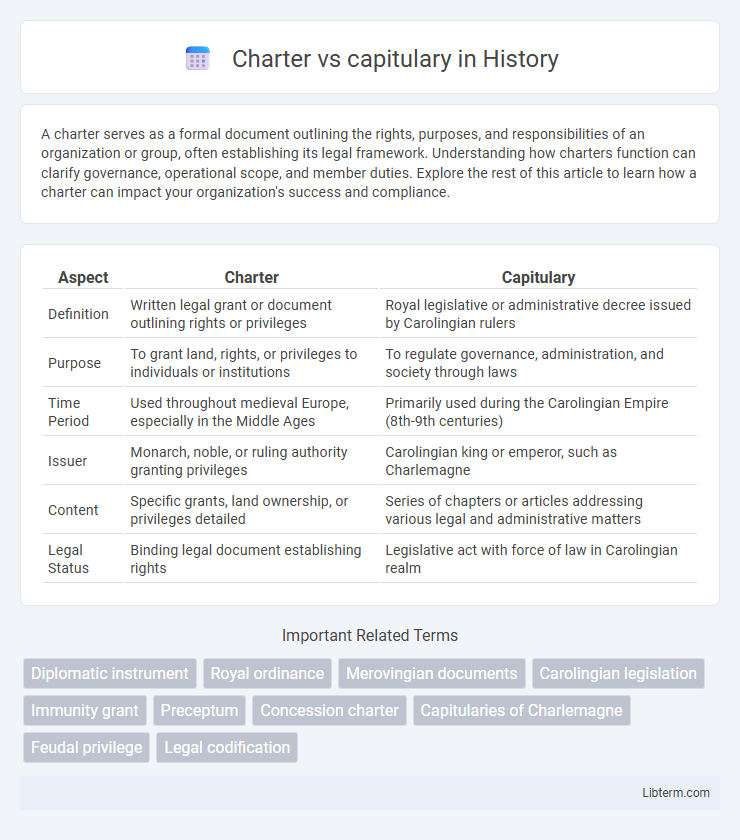A charter serves as a formal document outlining the rights, purposes, and responsibilities of an organization or group, often establishing its legal framework. Understanding how charters function can clarify governance, operational scope, and member duties. Explore the rest of this article to learn how a charter can impact your organization's success and compliance.
Table of Comparison
| Aspect | Charter | Capitulary |
|---|---|---|
| Definition | Written legal grant or document outlining rights or privileges | Royal legislative or administrative decree issued by Carolingian rulers |
| Purpose | To grant land, rights, or privileges to individuals or institutions | To regulate governance, administration, and society through laws |
| Time Period | Used throughout medieval Europe, especially in the Middle Ages | Primarily used during the Carolingian Empire (8th-9th centuries) |
| Issuer | Monarch, noble, or ruling authority granting privileges | Carolingian king or emperor, such as Charlemagne |
| Content | Specific grants, land ownership, or privileges detailed | Series of chapters or articles addressing various legal and administrative matters |
| Legal Status | Binding legal document establishing rights | Legislative act with force of law in Carolingian realm |
Introduction to Charters and Capitularies
Charters are formal documents granting rights or privileges, often issued by monarchs or lords, serving as legal proof of ownership or authority in medieval Europe. Capitularies are royal decrees or ordinances issued by Frankish kings like Charlemagne, designed to regulate administrative, judicial, or ecclesiastical matters across their realms. Both charters and capitularies played crucial roles in structuring governance and law, with charters emphasizing land grants and personal rights, while capitularies focused on centralized royal directives.
Historical Context and Origins
Charters emerged in medieval Europe as formal documents granting rights or property, primarily used by monarchs to legitimize land ownership and privileges. Capitularies were royal decrees issued by Frankish kings, especially under Charlemagne, organizing administrative and legal reforms to consolidate authority. Both originated in the Early Middle Ages but served distinct functions: charters as proof of legal transactions, and capitularies as instruments of governance and policy.
Definition of a Charter
A charter is a formal legal document issued by a sovereign or authority granting rights, privileges, or land to an individual or organization, serving as a written record of such grants. Unlike capitularies, which are royal ordinances or decrees typically issued by Frankish kings to regulate administration and justice, charters specifically document property rights, titles, or corporate privileges. Charters played a crucial role in medieval legal systems by providing tangible proof of ownership or authority, often sealed and preserved for legitimacy.
Definition of a Capitulary
A capitulary is a specific type of royal decree issued during the Carolingian Empire, comprised of chapters or sections that address administrative, legal, and ecclesiastical matters. Unlike a charter, which is a formal document granting rights or privileges to individuals or institutions, a capitulary serves as a set of legislative instructions or regulations issued by a monarch, particularly Charlemagne. The capitulary's purpose is to ensure uniform governance across territories by detailing laws, orders, and policies vital for the empire's administration.
Structural Differences
Charters, legal documents from the medieval period, typically exhibit a formalized structure comprising an invocation, disposition, legal grant, and witness list, often crafted on parchment for durability. Capitularies, legislated by Frankish kings like Charlemagne, are organized into chapters or sections addressing administrative, judicial, and ecclesiastical regulations, reflecting a more systematic codex format. The structural divergence lies in charters acting as individual property or rights conveyance documents, while capitularies serve as comprehensive legislative decrees assembled for governance and public administration.
Legal Authority and Functions
Charters served as formal legal documents granting privileges, land rights, or authority from monarchs or lords, establishing clear property ownership and jurisdictional rights within medieval legal systems. Capitulary referred to royal decrees or legislative orders issued by Frankish kings, particularly Charlemagne, which set administrative, judicial, and military regulations, reinforcing centralized legal authority. While charters focused on individual or local rights, capitularies functioned as overarching laws governing broader territorial administration and public policy enforcement.
Use in Medieval Governance
Charters in medieval governance served as formal legal documents granting rights, privileges, or land to individuals, institutions, or towns, playing a crucial role in establishing authority and property rights. Capitulary referred to royal decrees issued by Frankish kings, particularly Charlemagne, organizing administrative, military, or ecclesiastical matters to enforce central control across the realm. The use of charters empowered local authorities and facilitated decentralization, while capitularies emphasized royal authority and standardized governance throughout the empire.
Impact on Society and Administration
Charters formalized legal rights and land ownership, fostering a sense of stability and individual privilege within medieval society, while capitularies issued by rulers aimed to standardize administration and reinforce royal authority across diverse territories. The issuance of charters contributed to the growth of local governance and the establishment of feudal relationships, significantly influencing social hierarchies. Capitularies, by mandating uniform laws and administrative procedures, enhanced centralized control and improved the efficiency of government functions in early medieval Europe.
Key Examples in History
Charters, such as the Magna Carta of 1215, served as formal documents granting rights and privileges, often establishing legal frameworks for governance and property. Capitularies, exemplified by the Carolingian capitularies issued by Charlemagne in the 8th and 9th centuries, were royal decrees or legislative acts that organized administration and ecclesiastical matters across the Frankish Empire. Both documents played crucial roles in shaping medieval legal and administrative structures, with charters emphasizing individual or communal rights and capitularies focusing on centralized authority and policy implementation.
Conclusion: Significance and Legacy
Charters and capitularies were foundational legal instruments in medieval Europe, with charters primarily granting land and privileges, while capitularies issued royal directives to govern broader administrative and legal matters. Their significance lies in shaping feudal law and centralized royal authority, influencing the development of modern legal systems. The legacy of these documents endures in contemporary property law and administrative governance structures.
Charter Infographic

 libterm.com
libterm.com